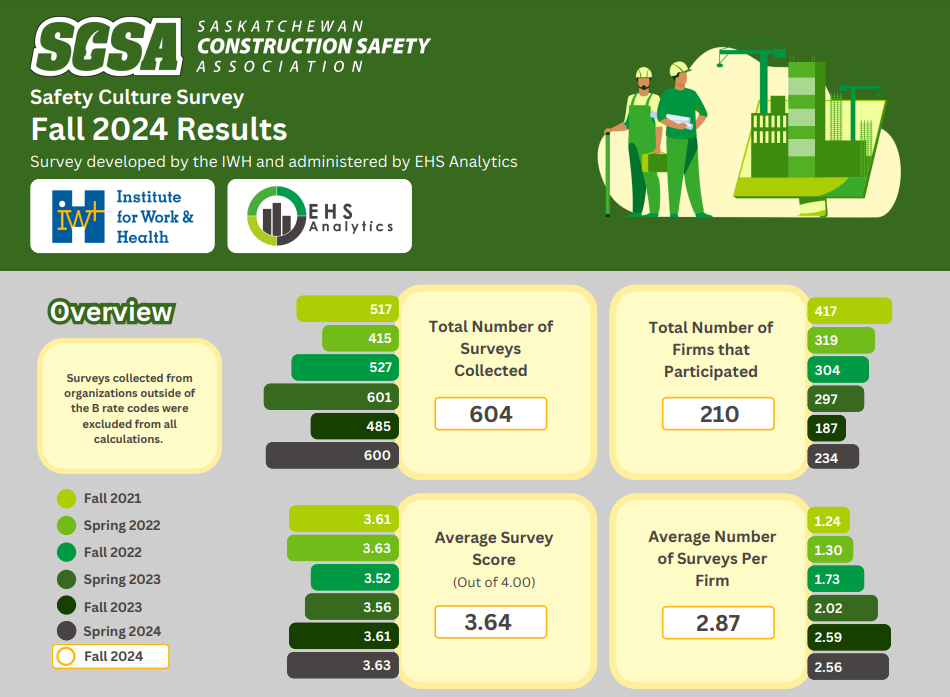Since October 2021, the Saskatchewan Construction Safety Association (SCSA) has been using the IWH-OPM safety culture survey to help construction firms assess and improve workplace safety. With support from EHS Analytics, these surveys provide critical insights into how employees perceive safety, allowing firms to take targeted action through analytics dashboards. The results have been impressive, with companies like Wright Construction demonstrating tangible improvements in safety culture through data-driven initiatives.
The Power of Measuring Safety Culture
The IWH-OPM (Organizational Performance Metric) survey is a simple, eight-question tool developed by the Institute for Work & Health (IWH). SCSA members voluntarily participate in the survey every six months, receiving access to an EHS Analytics dashboard that breaks down their results. Firms can benchmark their performance against industry averages, enabling them to pinpoint strengths and areas for improvement. Below are some of the results from the Fall 2024 Safety Culture Survey:

EHS Analytics has played a crucial role in making this data actionable. By analyzing survey responses and trends over time, SCSA and its members can track progress, compare results, and implement meaningful safety improvements.
Wright Construction’s Success Story
One of the firms leveraging the IWH-OPM survey is Wright Construction. When Bob Watson, Wright’s Health, Safety, and Environment Manager, joined the company in 2022, he saw the survey as a valuable tool to assess and enhance safety culture.
While Wright’s initial survey results in fall 2022 were strong, one area stood out for improvement: recognition of safe behavior. Employees did not feel that those who acted safely received enough positive acknowledgment. Watson and his team took immediate action, forming a subcommittee within their Joint Health and Safety Committee (JHSC) to address the issue. They introduced several initiatives:
-
Adding safety recognition shout-outs to weekly toolbox talks.
-
Incorporating a positive observations section in safety inspection forms.
-
Increasing the frequency of safety inspections from monthly to weekly.
-
Enhancing the field-level hazard assessment process.
By the fall 2024 survey, Wright Construction saw a marked improvement in both its overall safety culture score and the specific area of recognition. Watson credits the survey with helping identify areas for improvement and driving measurable change.
Industry-Wide Insights from EHS Analytics
EHS Analytics has taken a broader look at the data collected from six rounds of IWH-OPM surveys. In August 2024, the company published an analysis based on 3,150 surveys from 794 unique SCSA members. After filtering for statistical reliability, the final dataset included 252 firms and 1,643 surveys. Key findings included:
-
Firms with a Certificate of Recognition (COR®) consistently had higher IWH-OPM scores.
-
Companies with higher IWH-OPM scores experienced significantly lower lost-time injury rates in the six months following the survey.
-
The IWH-OPM score may serve as a leading indicator of safety outcomes.
The insights from the EHS Analytics dashboard empower organizations to refine their outreach strategies, fostering a stronger and more proactive safety culture.
The Future of Safety Culture Measurement
The IWH-OPM survey is conducted every six months and firms can use the EHS Analytics dashboard to monitor trends and track the impact of their safety initiatives. By leveraging EHS Analytics dashboards and insights, the SCSA and its members are taking a data-driven approach to workplace safety.
Read the full IMPACT CASE STUDY by the IWH here: https://www.iwh.on.ca/impact-case-studies/saskatchewans-construction-safety-group-uses-iwh-tool-to-improve-safety-culture